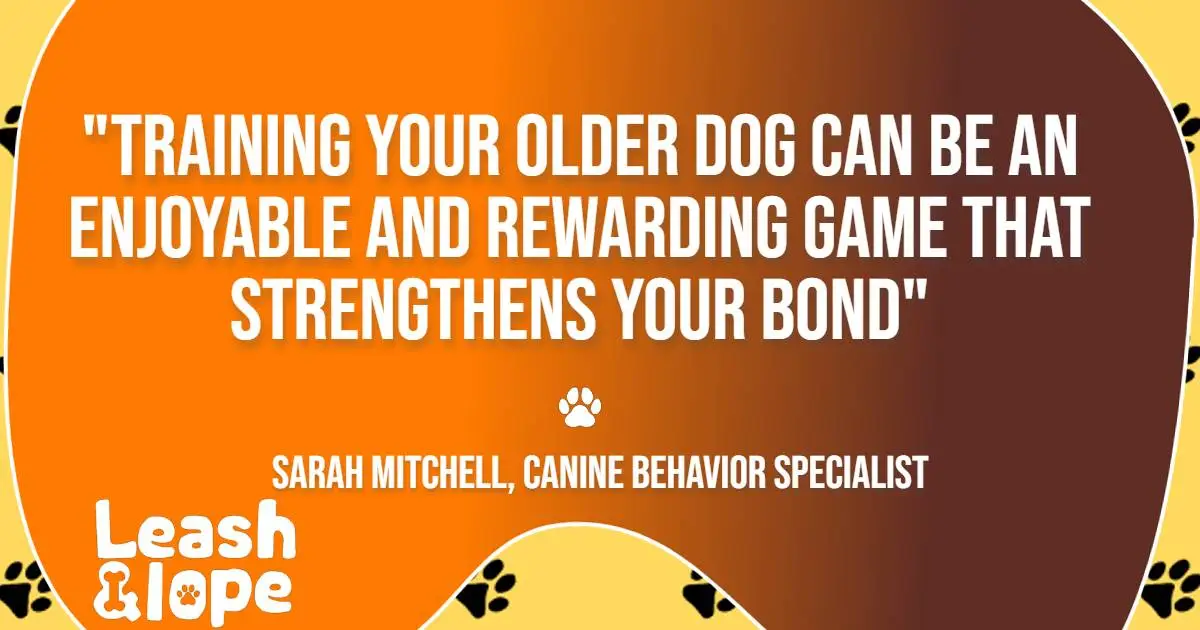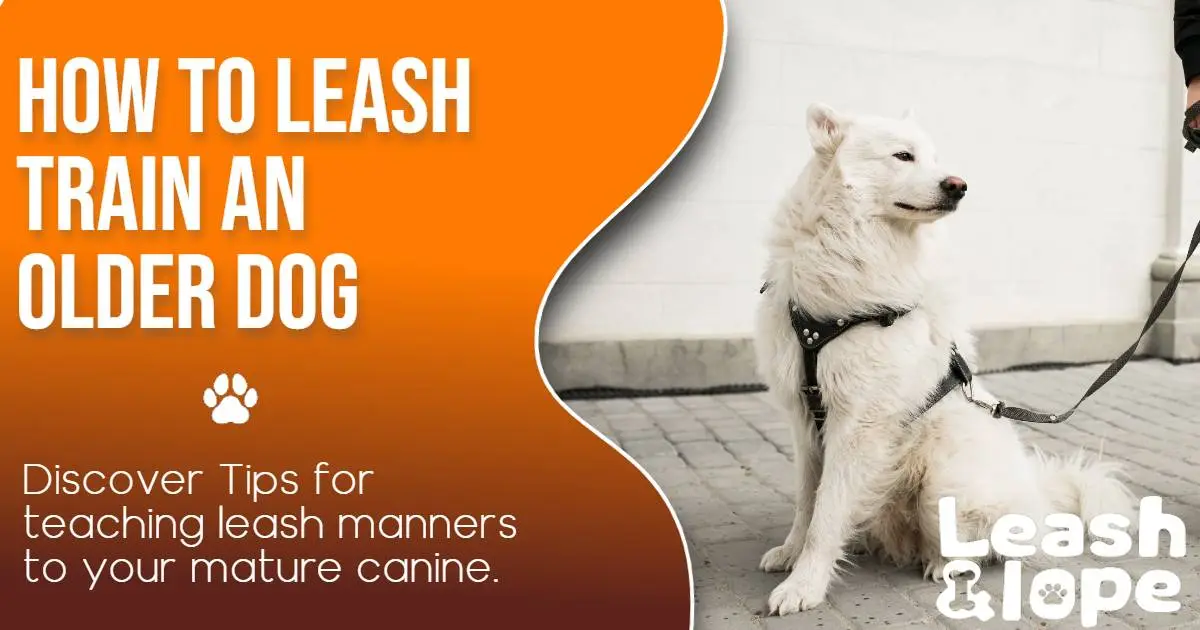Have you recently welcomed an older dog in your family but you’re put off by his behavior? Do you want to change his attitude? If that’s so, you’re at the right place. You might be wondering if you can leash train an older dog or if the older dogs can be trained. The answer is: YES! They can be taught but it can be a bit more challenging compared to younger dogs
This article will be all about providing some techniques along with practical tips, valuable insights, and expert advice to help you master the art of leash training an older dog.
Why Training an Older Dog is More Challenging Than Younger Pups
Leash train an older dog can be a bit more challenging compared to their younger counterparts. You may be wondering why.

1. Established Behavior
Older dogs might have already established certain behaviors and routines over the years. It’s like they’ve become set in their ways. Breaking those habits and teaching them something new can take a bit more effort and patience.
2. Physical limitations
Older dogs might have physical limitations or health issues that can impact their ability to learn. Just like humans, as dogs age, they might develop joint problems or other conditions that make certain exercises or movements uncomfortable. This can slow down the training process and require adjustments to accommodate their needs.
3. Life Situations
Older dogs may have experienced different life situations that could affect their behavior. They might have had previous owners or been through various environments that shaped their personalities and responses. These past experiences can sometimes make it harder for them to adapt to new training methods or commands.
10 Tips to Leash Train an Older Dog

The following tips and tricks will help you in leash train an older dog.
1. Recognize the Issues
First, spend some time with your older dog to see what behaviors in him you’d like to modify and improve. Recognizing the issue before leash training your older dog is important because it helps you understand what specific challenges you might face and tailor your training approach accordingly.
Each dog is unique, just like us humans, so understanding their behavior and any underlying issues can make the training process smoother and more effective.
Observe his doings in your home. Take him out for a walk, and see how he behaves with and without a leash. Also, observe his demeanor around other dogs and people.
If you see that he’s not properly leash trained or not leash trained at all—try to start the training from the basics, while taking care of his overall wellness.
2. Check Your Dog’s Fitness
Checking your older dog’s health before starting leash training is super important because just like us, our furry friends can have some underlying health issues that might affect their ability to walk or exercise comfortably.
By getting them checked by a veterinarian, you’ll have peace of mind knowing that they’re physically fit for the training and that you won’t add fuel to the fire by initiating the training process.
Plus, it’s always good to rule out any potential pain, discomfort, or underlying issue that could become a cause of any hindering in their training or overall progress.
3. Choose the Right Equipment
When it comes to equipment for leash training an older dog, there are a few options you can consider. It’s likely that your senior dog must be familiar with a leash and harness. In case he’s not, familiarize him.
Firstly, you’ll need a sturdy and comfortable leash that’s appropriate for your dog’s size and strength. A standard nylon or leather leash is usually a good choice.
Then, you can decide between using a collar or a harness. Collars are more commonly used and work well for most dogs, but if your furry friend tends to pull or has any neck or throat issues, a harness might be a better option as it distributes the pressure more evenly.
It’s always a good idea to consult with a professional or do some research to find the best fit for your dog’s specific needs.
Now, you can let your dog sniff the leash before you put it on him. Gradually, introduce the leash by attaching it to the harness while indoors. Allow your dog to walk freely in your house with the leash dragging behind them so that they can get used to its sensation.
Once he gets comfortable with it, you can pick up the leash and walk them around gently. Don’t forget to reward them.
5. Basic Obedience Training
Ensure that your dog responds to your commands so that it can help you in training them on a leash if they start showing pulling or you have a hyperactive dog. Here are a few tips to get you started:
- Start with the basics: Teach your older dog commands like “sit,” “stay,” and “come.” Use treats as rewards to motivate them.
- Be positive: Older dogs may take longer to learn new things, so it’s important to stay positive and encourage them throughout the process. Lots of praise and treats will go a long way.
- Keep it short and sweet: Older dogs might have shorter attention spans, so keep your training sessions brief, around 10-15 minutes, to prevent them from getting bored or overwhelmed.
- Use positive reinforcement: Reward your dog with treats, praise, and affection whenever they perform the desired behavior correctly. This will help reinforce their understanding of what you’re asking them to do.
- Refrain from using harsh discipline: Punishment-based training for dogs is not the best approach because it can have some negative consequences. When we use punishment, it can create fear or anxiety in our furry friends, which can lead to unwanted behaviors or even aggression. Plus, it can damage the trust and bond between us and our pups.
- Initiate the training: Now that you’ve taken care of some basic needs of your dog for his physical and mental health, it’s time to start the training.
6. Choose a Quiet Environment
Start the training in a quiet environment to avoid a large number of distractions for your dog. A calmer environment can help your dog focus on training in a better way. Once they become comfortable, you can gradually increase the distractions.
7. Handle Hyperactivity
If your dog starts showing signs of hyperactivity, you don’t need to worry because this problem is totally fixable. Sometimes our furry friends just get a little too amped up or overwhelmed. We’ve got your back with this step-by-step guide that’ll come to the rescue. Just follow the simple steps mentioned in this guide and you’ll be able to tackle that hyperactivity issue like a pro. Trust me, it’ll make a world of difference for both you and your furry buddy.
8. Handle Pulling Behavior
Another problem that you might face while leash training an older dog is his pulling behavior. That’s something that a lot of dog owners face. We’ve already provided a comprehensive guide here in this regard which is specifically designed to help you tackle this pesky behavior of your dog. We’ve got your back with an awesome guide that’s specifically designed to help you tackle this pesky behavior head-on. It’s full of tips and tricks that’ll work wonders in getting your furry friend to walk nicely by your side.
9. Positive Reinforcement
Never underestimate the importance of positive reinforcement when it comes to training dogs of any age. A pocketful of treats and a heap of encouragement goes a long way in making the training successful.
10. Balancing Patience With Consistency
As much as it sounds cliché, patience and consistency, both play such a great role when it comes to training dogs. Since older dogs already have well-established behaviors and habits, reshaping them or forming new ones can take a lot of time and dedication.
So, don’t let frustration get the best of you, rather deal with it with love and positivity. Remember, every small step forward counts, and with your unwavering patience and consistent guidance, you’ll be amazed at the progress your four-legged buddy can make.
For any reason if your dogs are not into running switch to alternatives to physical exercise for dogs.
4 Reasons to Consider Leash Train an Older Dog
Training an older dog is important for his overall well-being and your bond with him. Some of the reasons that serve as evidence in this regard are:
1. Development of a Strong Bond
It helps establish a strong bond between you and your senior furry friend. Through training, you both learn to communicate effectively and understand each other’s cues and signals. It creates a sense of trust and mutual respect, which can deepen your relationship.
2. Mental Stimulation
Training provides mental stimulation for older dogs. Just like us humans, dogs need mental exercise to keep their minds sharp and engaged. Learning new commands or tricks challenges them and prevents boredom or behavioral issues that can result from a lack of mental stimulation.
3. Adapting to New Situations
Training helps older dogs adapt to new situations or environments. It equips them with the skills and behaviors necessary to navigate the world around them with confidence. Whether it’s walking on a leash, interacting with other animals, or following basic commands, proper training ensures their safety and well-being.
4. Physical Health
Training can also be beneficial for their physical health. Certain exercises or activities incorporated into training routines can help maintain their mobility, flexibility, and overall fitness levels.
So, by investing time in training your older dog, you’re not only enhancing their quality of life but also creating a harmonious and enjoyable companionship, regardless of the age.
Is it a Myth that Older Dogs Can’t Be Trained Again?
Yes, for sure. While training an older dog may require a bit more time and effort, it’s definitely not an impossible task. The tricks used for training both young and adult dogs are the same, but there’s a little twist in them. This is because of the above-mentioned factors.
Dogs are eager learners and hence, their learning capabilities can be nourished throughout their lives. Patience, consistency, and the right approach are needed in this regard.
How to Teach an Older Dog to Heel
Teaching an older dog to “heel” is a training command that involves teaching the dog to walk calmly and closely by your side, typically on a leash.
Teaching an older dog to heel may require more patience and consistency than compared to a younger one. But, it’s possible. Start by using a leash or harness. Make sure to do everything when there is no distraction so the dogs fully concentrate on it.
A study published in the Journal of the Experimental Analysis of Behavior (2009), help reinforce desired behaviors, making it more likely that your older dog will master the heel command through consistent practice and a positive learning experience.
Employ positive reinforcement techniques, such as treats and praise, to reward your dog when they walk calmly by your side.
Use a consistent command like “heel” and maintain the proper position with your dog on your preferred side. Correct any wandering or pulling gently but firmly, ensuring the leash has some slack.
Final thoughts: Leash Train an Older Dog
Leash training an older dog may take more time and effort, but it is definitely possible. As we know older dogs may have physical limitations or health issues that may affect their ability to learn new things, so go at your own pace and don’t get discouraged if progress is slow. So, it’s important to approach the training process with understanding and empathy.
Take breaks when needed and make sure they’re comfortable throughout the training sessions. With time and dedication, you’ll see progress and enjoy peaceful walks with your older dog by your side.

Dr. Haider is a general doctor with a unique level of connection to our four-legged friends. He is a valued contributor to our Website (Leash and Lope). Dedicated to providing accurate to dog owners in understanding and caring for their lovely pets.

